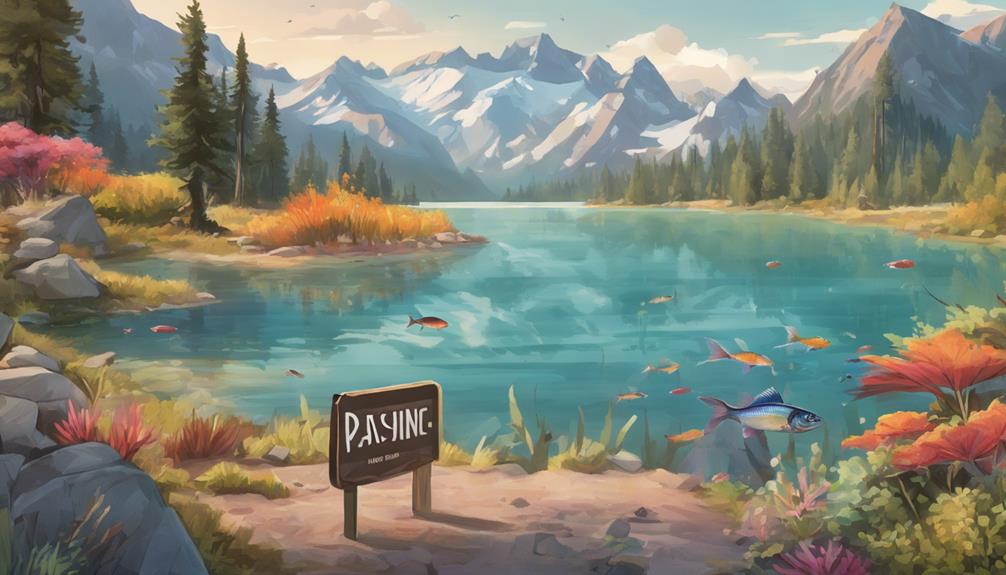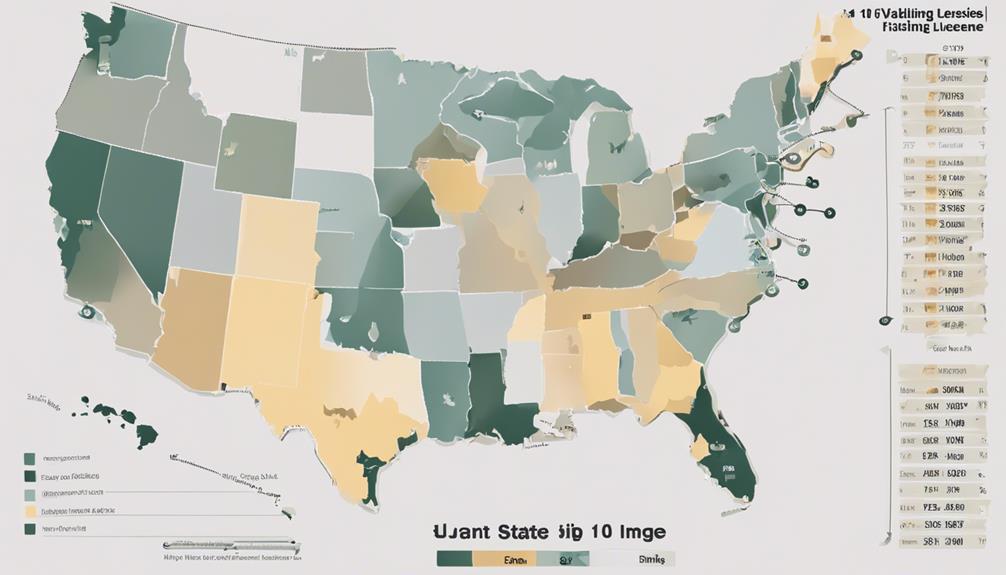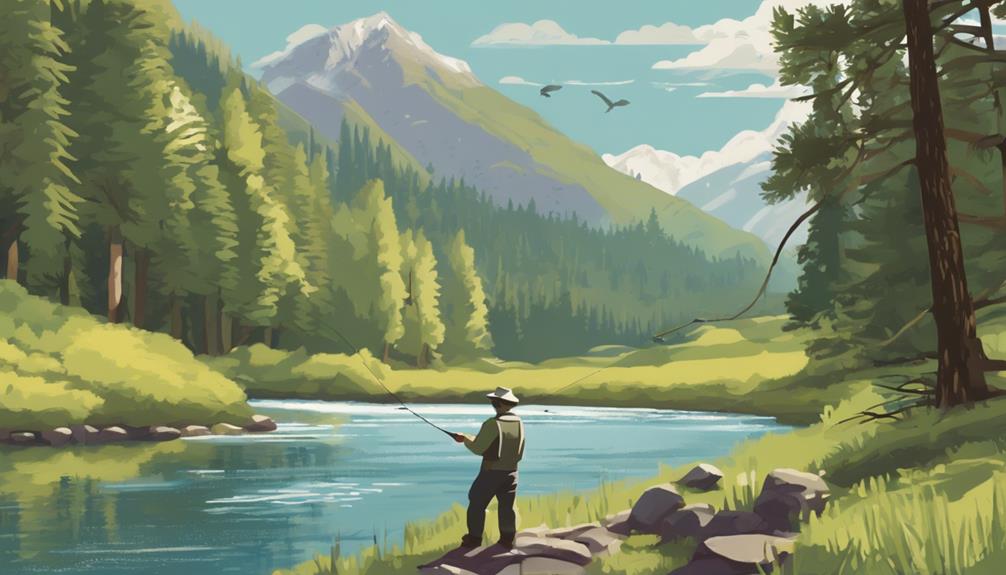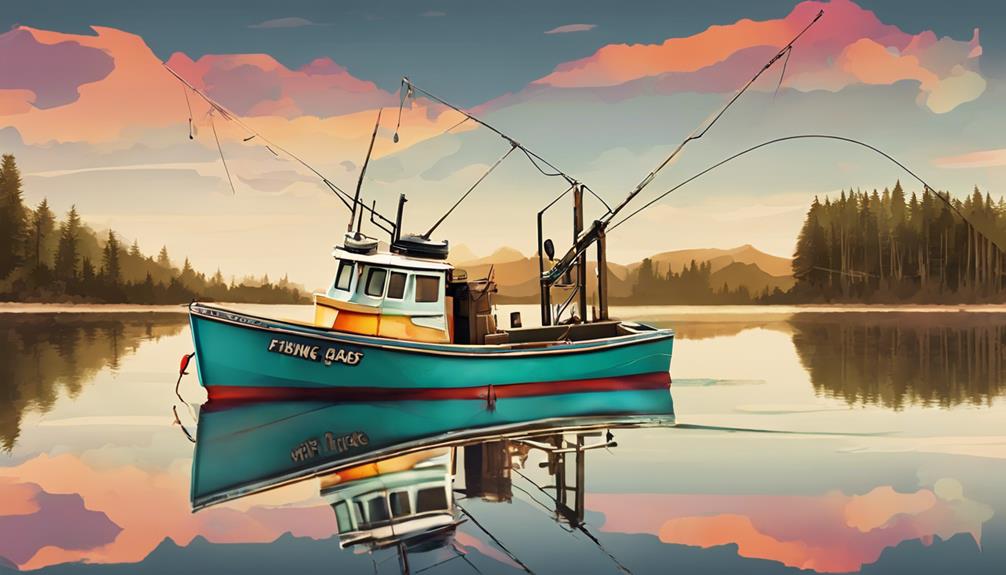Ever wondered why national parks have strict fishing regulations in place?
Imagine a delicate balance that needs to be maintained. To ensure the preservation of these natural wonders, fishing regulations play a crucial role. By establishing rules and limits, national parks aim to protect the delicate ecosystems thriving beneath the water's surface.
However, there are more reasons behind these regulations that you might not have considered. Understanding these factors sheds light on the importance of adhering to the guidelines set forth in these protected areas.
Conservation of Fish Populations
To ensure sustainable fishing practices in national parks, it's crucial to understand and abide by the regulations put in place for the conservation of fish populations. Fish population management is essential to maintain the ecological balance within these delicate ecosystems. By preserving fish habitats, national parks aim to support biodiversity and ensure that fish populations thrive.
Habitat preservation is a key aspect of fish population management in national parks. These areas serve as sanctuaries for various fish species, providing them with shelter, food sources, and breeding grounds. By protecting these habitats, national parks contribute to the overall health of fish populations and help maintain the ecological balance of aquatic ecosystems.
Furthermore, biodiversity maintenance is closely linked to the conservation of fish populations in national parks. Fish play a crucial role in the food chain, and their presence or absence can have significant effects on other species within the ecosystem. By ensuring the sustainability of fish populations, national parks help preserve the diversity of plant and animal life that depends on healthy fish populations for survival.
Protection of Native Species
Conserving native species is a fundamental aspect of maintaining biodiversity in national parks. National parks implement fishing regulations to protect native species, ensuring their populations remain stable and diverse. These regulations serve to safeguard the delicate balance of ecosystems by preventing overfishing and habitat degradation. By controlling fishing activities, parks can also focus on habitat restoration efforts to enhance the environment for native species to thrive.
The protection of native species through fishing regulations is crucial for preserving the overall biodiversity within national parks. Native species play a vital role in maintaining the ecological balance of these protected areas. By safeguarding their habitats and populations, parks can promote a healthy and sustainable environment for all species to coexist harmoniously.
Furthermore, these regulations aid in the restoration of habitats that may have been affected by human activities or natural events. By limiting fishing in certain areas or during specific times, parks can give native species the opportunity to recover and replenish their populations. This restoration process is essential for ensuring the long-term survival of these species and maintaining the overall health of the ecosystem.
In essence, the protection of native species through fishing regulations in national parks is a proactive approach to conservation. By prioritizing biodiversity and habitat restoration, parks can continue to be havens for a wide variety of species to thrive and contribute to the richness of our natural world.
Prevention of Overfishing
The national parks' fishing regulations prioritize preventing overfishing to maintain healthy fish populations and preserve the ecological balance. Overfishing can disrupt the delicate ecological balance by depleting fish populations beyond their capacity to recover. By implementing fishing regulations, national parks can effectively manage their resources and ensure sustainable fishing practices.
Effective resource management is crucial for maintaining the health of aquatic ecosystems within national parks. Overfishing can lead to a decline in fish populations, affecting not only the fish themselves but also other species that depend on them for food. When fish populations are depleted, it can disrupt the food chain and impact the overall ecosystem's stability. By preventing overfishing, national parks can protect the biodiversity of their waters and preserve the natural habitats of various species.
Preserving the ecological balance through the prevention of overfishing also contributes to the long-term sustainability of the national parks' resources. By setting limits on fishing activities and enforcing regulations, park authorities can ensure that fish populations remain at healthy levels. This not only benefits the fish themselves but also the recreational and economic activities that rely on a thriving ecosystem. Ultimately, prioritizing the prevention of overfishing in national parks is essential for maintaining the ecological balance, protecting biodiversity, and promoting sustainable resource management practices.
Preservation of Aquatic Ecosystems
Preserve the delicate balance of aquatic ecosystems by ensuring sustainable fishing practices within national parks. When fishing in these protected areas, it's crucial to consider the impact on the aquatic environment to maintain its health and diversity. Here are some key aspects to focus on:
- Water quality: The quality of water in aquatic ecosystems is vital for the survival of various species. Pollution from fishing activities can introduce harmful substances into the water, affecting not only the fish but also other aquatic organisms and plants. By following regulations and using eco-friendly fishing gear, you can help preserve the pristine water quality within national parks.
- Habitat preservation: Aquatic ecosystems provide habitats for a wide range of species, including fish, amphibians, and aquatic plants. Overfishing or destructive fishing practices can disrupt these habitats, leading to a loss of biodiversity and imbalance in the ecosystem. By respecting fishing regulations and avoiding activities that harm the habitat, you contribute to the preservation of these critical environments.
- Sustainable fishing practices: Adhering to catch limits, using barbless hooks, and practicing catch-and-release fishing are all ways to ensure sustainable fishing within national parks. By promoting responsible fishing behavior, you help maintain fish populations at healthy levels and support the long-term sustainability of aquatic ecosystems.
- Ecosystem resilience: Healthy aquatic ecosystems have a better capacity to withstand environmental changes and disturbances. By fishing responsibly and respecting the delicate balance of these ecosystems, you play a crucial role in enhancing their resilience to threats such as climate change and pollution.
Maintenance of Park Sustainability
Ensuring the long-term sustainability of national parks involves actively managing resources and minimizing environmental impact. National parks are delicate ecosystems that require careful attention to maintain ecological balance. Fishing regulations play a crucial role in the maintenance of park sustainability by regulating the exploitation of fish populations and preserving the overall health of aquatic environments.
Effective resource management is essential for preserving the ecological balance within national parks. By implementing fishing regulations, park authorities can control the number of fish being caught, ensuring that populations remain at healthy levels. Overfishing can disrupt the natural balance of an ecosystem, leading to cascading effects on other species and the environment as a whole. Through the enforcement of fishing restrictions, parks can protect their biodiversity and promote the long-term health of aquatic habitats.
Furthermore, fishing regulations contribute to sustainable resource management practices. By setting limits on catch sizes, species, and fishing methods, parks can prevent depletion of fish stocks and minimize environmental damage. Sustainable fishing practices help maintain the integrity of aquatic ecosystems, allowing for continued enjoyment of fishing activities for future generations.
Regulation of Angler Behavior
To maintain park sustainability, it's imperative to regulate angler behavior effectively. Anglers play a crucial role in preserving the delicate balance of ecosystems within national parks. By promoting responsible angling practices, we can ensure the longevity of fish populations and the overall health of aquatic environments.
Effective Regulation of Angler Behavior:
- Angler Education: Providing anglers with educational resources on best practices, species identification, and the importance of conservation can help instill a culture of responsible fishing.
- Catch and Release: Encouraging anglers to practice catch and release can significantly reduce the impact on fish populations. This practice involves catching a fish and then releasing it back into the water unharmed.
- Barbless Hooks: Requiring the use of barbless hooks can make it easier to release fish without causing unnecessary harm. This regulation promotes ethical angling practices.
- Proper Waste Disposal: Instructing anglers on the proper disposal of fishing waste, such as fishing lines and bait containers, prevents littering and protects wildlife from ingesting harmful materials.
Enforcement of Catch Limits
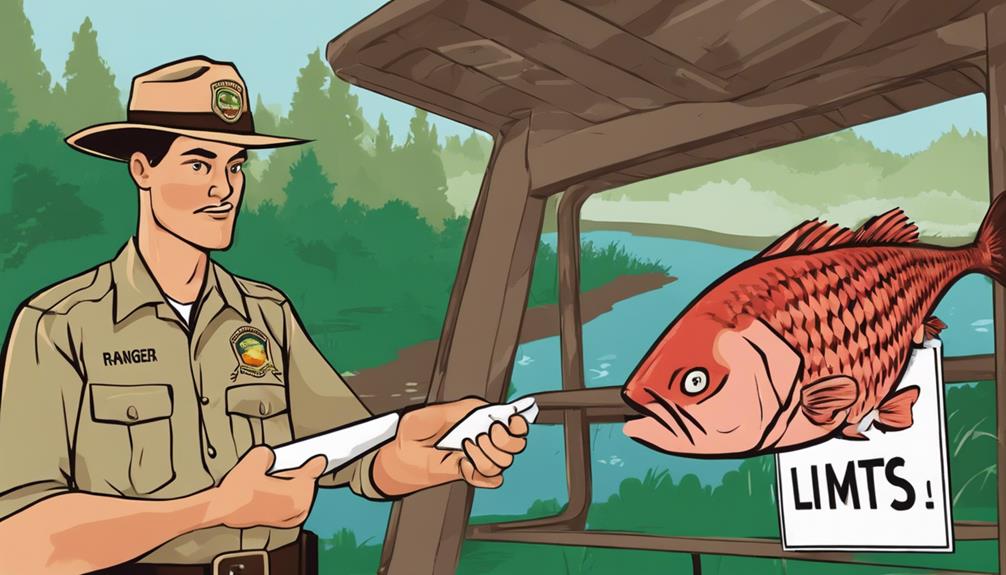
Regulate angler behavior effectively by enforcing catch limits to maintain the sustainability of national park ecosystems. Monitoring compliance with catch limits is crucial for preserving fish populations and ecosystem balance. Park rangers and officials often utilize various methods to ensure anglers are abiding by these regulations.
One common approach is through data collection. By monitoring the number and size of fish caught, authorities can assess if anglers are staying within the designated limits. This data helps in understanding the impact of fishing activities on the environment and assists in making informed decisions to protect the ecosystem.
Community engagement plays a significant role in enforcing catch limits. Through educational outreach programs, park staff can inform anglers about the importance of adhering to regulations. By raising awareness about sustainable fishing practices and the reasons behind catch limits, visitors are more likely to comply voluntarily.
Regular patrols and checks at fishing spots are also essential for enforcing catch limits. By having a visible presence, rangers deter individuals from exceeding the set limits. Those found violating regulations can be educated on-site about the consequences of their actions, reinforcing the importance of conservation efforts in national parks.
Promotion of Responsible Angling
Encourage anglers to practice responsible fishing habits to preserve the natural beauty and diversity of national park ecosystems. By promoting ethical fishing practices, you contribute to the conservation of these precious environments. Here are some ways to ensure you're fishing responsibly in national parks:
- Environmental Education: Take the time to learn about the specific rules and regulations of the national park you're visiting. Understanding the local ecosystem and the impact of fishing on it will help you make informed decisions while angling.
- Catch and Release: Consider releasing your catch back into the water to help maintain the natural balance of the ecosystem. This practice is crucial, especially for endangered species or in areas where overfishing is a concern.
- Proper Waste Disposal: Always dispose of your fishing line, hooks, and any other waste properly. Leaving behind fishing gear can harm wildlife and disrupt the natural habitat. Be sure to pack out all your trash to keep the environment clean.
- Lead by Example: Share your knowledge of ethical fishing practices with fellow anglers. By setting a positive example and educating others, you can help protect national park ecosystems for future generations to enjoy.
Frequently Asked Questions
Can I Bring My Own Fishing Equipment Into the National Park or Do I Need to Rent It?
You can bring your fishing equipment into the national park. Regulations may apply, so make sure to check them before your trip.
Rental options might be available if you prefer not to bring your own gear. It's always a good idea to plan ahead and see what rental services are offered within the park.
Enjoy your fishing adventure while following the park's regulations to help preserve the natural beauty for everyone to enjoy.
Are There Any Specific Restrictions on the Types of Bait or Lures That Can Be Used for Fishing in National Parks?
When fishing in national parks, there are usually restrictions on the types of bait or lures you can use. These rules help protect the types of fish found in the park and ensure sustainable fishing practices.
Some parks may have specific guidelines on the types of bait allowed to prevent harm to the ecosystem. Make sure to check the park's regulations before heading out to fish and familiarize yourself with approved fishing techniques.
Are There Designated Fishing Areas Within the National Park or Can I Fish Anywhere?
You can fish in designated areas within the national park. Fishing boundaries are set to protect wildlife and the environment. Conservation efforts aim to ensure sustainable fishing practices.
Do I Need a Fishing License to Fish in National Parks, and if So, Where Can I Obtain One?
You need a fishing license to fish in national parks. Fishing regulations are enforced to protect the ecosystem.
You can obtain a license at designated park offices or online. Some exemptions may apply, like for children or certain special events.
Make sure to follow all rules and guidelines to help preserve the natural environment and ensure a sustainable fishing experience for all visitors.
Are There Any Seasonal Restrictions on Fishing in National Parks, and if So, When Are They Enforced?
Seasonal restrictions on fishing in national parks are in place to protect wildlife during critical breeding times and ensure sustainable fishing practices. Regulations dictate when and where fishing is allowed to prevent overfishing and protect vulnerable species. These measures support conservation efforts and help maintain the delicate balance of ecosystems within the park.
Be sure to check fishing seasons and regulations before casting your line to help preserve the natural beauty of these protected areas.
Conclusion
So next time you visit a national park and want to go fishing, remember that the regulations in place are there for a reason. By following these rules, you're helping to:
- Conserve fish populations
- Protect native species
- Prevent overfishing
- Preserve aquatic ecosystems
- Maintain park sustainability
- Regulate angler behavior
- Enforce catch limits
- Promote responsible angling
So grab your gear, follow the rules, and enjoy a day of fishing while also contributing to the protection of these beautiful natural areas.
